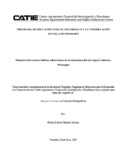Situación del recurso hídrico subterráneo de la subcuenca del río Aguas Calientes, Nicaragua
Date
2005Author
Obando Soriano, F.O.
Autor Corporativo
CATIE - Centro Agronómico Tropical de Investigación y Enseñanza
Type
Tesis de maestría
Metadata
Show full item recordAlternative title
Undeground water resources situation of the Aguas Calientes river watershed, Nicaragua
Description
Tesis (Mag. Sc.) -- CATIE, 2005
Abstract
Mediante el uso del modelo DRASTIC, desarrollado por la Agencia de Protección Ambiental (EPA) de los Estados Unidos se evaluó la vulnerabilidad ambiental del recurso hídrico subterráneo de la subcuenca del río Aguas Calientes en Somoto-Madriz, Nicaragua. El objetivo principal fue identificar zonas donde el recurso agua subterránea es más susceptible a contaminación, determinándose áreas prioritarias de protección. En cuanto a vulnerabilidad a pesticidas un 8,58 por ciento del territorio de la subcuenca del río Aguas Calientes posee una vulnerabilidad baja, en tanto que el 27,81 por ciento posee una vulnerabilidad moderada y el 10,98 por ciento posee una vulnerabilidad alta, está última zona ubicada específicamente en las comunidades de Aguas Caliente y la parte baja de Santa Rosa. Encontrando que la mayor cantidad de agua proviene del río Coco a travéz de terrazas aluviales y fallas geológicas que se interconectan en el área de alta vulnerabilidad a pesticidas. The environmental vulnerability of the underground water of the Aguas Calientes river watershed was evaluated in Somoto-Madriz, Nicaragua using the DRASTIC model developed by the Environmental Protection Agency (EPA) of the United States. The main objective was to identify areas where the underground water is more vulnerable to contamination. The vulnerability to pesticides where low in about 8,58 per cent of territory, 27,81 per cent has a moderate vulnerability and the communities of Aguas Calientes and the lower part of Santa Rosa has a high vulnerability level, representing 10,98 per cent of the territory. The main recommendation of this research, is that there is an important need to develop a hydro-meteorological monitoring system for the watershed. With that information the local government would be able to take the best decisions related to the management of this important resource in the area.
Keywords
Delegation
Sede Central
Asesor
Solís, H.
Publisher
CATIE, Turrialba (Costa Rica)
URI (Permanet link to cite or share this item)
https://repositorio.catie.ac.cr/handle/11554/4229Collections
- Tesis [1392]


